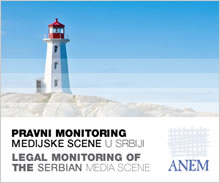Home
/
Media Scene
/
In Focus
03. 06. 2005
PROPOSAL FOR BROADCAST DEVELOPMENT STRATEGY
The Association of Independent Electronic Media (ANEM) welcomes the decision of the republic’s Broadcast Agency Council to involve professional broadcast associations in the process of preparing the Broadcast Development Strategy. ANEM believes that the development of the broadcasting sector in the Republic of Serbia must be in line with the regulations of Article 3 of the Broadcast Act. 1. CURRENT STATE OF THE BROADCASTING SECTOR The current state of the broadcasting sector in Serbia is somewhat chaotic and absolutely unacceptable. Its principal features are a proliferation of electronic media and a lack of respect for professional ethics, technical and program standards, and copyright and related rights, particularly the rights of consumers. Given the general belief that the priority of the Strategy is to offer solutions rather than allocate blame, we would note that the reasons for the present situation may be found in the period before the democratic changes in the country, as well as after October 5, 2000. The regime of Slobodan Milosevic was marked by media repression, an utterly arbitrary and non-transparent procedure for issuing licences, questionable justifications for the closure of radio and television stations on the grounds of technical shortcomings and deliberate support for the uncontrolled proliferation of broadcast media in order to reduce the broadcast space available for objective information and critical opinion by merely broadcasting cheap entertainment. Since the democratic changes of October, 2000, the newly appointed authorities have complicated the situation further with a lack of decisiveness and outright errors (such as the legally questionable moratorium on new licences, which was never proclaimed in the Official Gazette and which was, in fact, simply a statement by the Federal Government which had abrogated the law in defiance of the Constitution, a situation which lasted too long). Finally, in an era when countries with better regulations are embracing digital broadcasting, Serbia has still not regulated the chaotic state of analogue terrestrial broadcasting. 2. TRANSFORMATION OF RADIO TELEVISION SERBIA The starting point of the Broadcast Development Strategy must be the transformation of RTS into a national and regional public service. Full implementation of the legal framework defined by the Broadcast Act of 2002 is inconceivable without such a transformation. The goal of this transformation as defined by the Act is the establishment of a national and regional public service with sufficient maturity to serve the public interest. In pursuit of this goal, RTS must be radically restructured, including those parts of the system not directly linked to the general interests of the broadcast service. Given the responsibility of a public broadcasting service provider and the authority of the Broadcast Agency in the implementation and affirmation of the principles of regulating relations in the broadcast sector together with the performance of the duties of broadcasters, including the institutions of the broadcasting service, the Republic Broadcast Agency must be unequivocally and actively involved in the process of restructuring and transforming RTS. The Agency must not wait for solutions proposed by the government or by RTS itself. It is in the public interest that the Agency must take the initiative and define the steps to be taken in achieving the goals defined by the Act. In the light of this it is essential that broadcasting is transferred only to those networks envisaged by the Broadcast Act and transmission facilities made independent of Radio Television Serbia. The reasons for separating the transmission facilities will become clear later in this document. As far as broadcasting on a smaller number of networks goes, the legal obligation is very clear: any privatisation of the RTS Third Channel or one of its radio stations should not hinder the process of broadcast licences being issued as stipulated by the Act. Thus it would be necessary to stop broadcasting on the Third Channel as soon as possible, and certainly before any privatisation, so giving potential purchasers of the station a clear message that they may resume broadcasting only once a licence is obtained through regular procedures, at public tender and under conditions which are equal for all bidders. However the Broadcast Act also stipulates that the resources for establishing and operating the Broadcast Institutions of Serbia and the Broadcast Institutions of Vojvodina comprise the property and other assets of the Public Company Radio Television Serbia. ANEM believes that the privatisation of certain components of RTS would reduce the property of the station in a way directly contrary to the intent of the legislation. 3. COMMERCIAL BROADCASTERS IN THE TRANSFORMATION PERIOD Just how long the process of transforming RTS into a public service will take is rather unclear, and no one knows when we as a society will be able to say that the results achieved are satisfactory and the interest of the public have been effectively met. ANEM is an association of commercial broadcasters including some which will become commercial stations in the process of privatising local media, but despite this, the association is aware of this social turning point and the level of responsibility which must be shouldered by commercial broadcasters, particularly where the variety of programming is concerned. It is essential that commercial broadcasters, during the period of RTS transformation, take their share of the burden in ensuring that the needs and general interest of the public are met in a way appropriate to a public broadcast service. This means primarily that broadcast licences, particularly licences for terrestrial broadcasting with national and regional coverage, must be given on condition of providing general quality and variety until the completion of transformation of RTS enables it, as a public service, to perform effectively the role envisaged by the Act. This means that the programs of commercial broadcasters must be adjusted to the general public and not focused only on the limited target groups which are particularly attractive for the advertising agencies and advertisers, individual demands and, on the broadest level, the financial and political centres of power. During this transition period the Agency must make the same demands of the commercial broadcasters as it does of the public service. They must be required to provide free, complete and up-to-date information as the root of freedom of opinion and act as a public forum in which people can hear appropriate opinions, improve social cohesion, define a cultural mission and invest in high-quality domestic programs. 4. SERVICE ZONES Article 47 of the Broadcast Act stipulates that the desired zone of the service may include the area of the Republic of Serbia, autonomous provinces, regional and local areas. While the concepts and perimeters of the Serbian region and autonomous provinces are explicit, the meaning of regional and local areas must be defined by the Broadcast Development Strategy. However, broadcasting regions may not be defined merely by the administrative borders of the district, but also by geographical aspects: the configuration of the terrain, cultural and historical heritage, existing broadcasting facilities and internationally coordinated frequencies and channels. On the other hand, considering the necessary economic base for economically viable broadcasters which would meet the quality criteria, it is desirable for broadcasting regions to be areas with a population of between 0.5 and 1.5 million. This may be smaller or greater, where valid geographical, cultural or historical reasons exist. In the light of this, ANEM accepts the general proposal for a prospective definition of broadcasting regions in the Republic of Serbia, as adopted by the Broadcast Agency Council in a meeting on May 17, 2005. The proposal is for nine broadcasting regions in Serbia: two in Vojvodina (one in the Banat region and the other for the region of Srem and Backa), the Belgrade region and the regions of Macva, Eastern Serbia, Central Serbia, Western Serbia, Raska and Southern Serbia. The Act stipulates that the desired service zone may also enclose a provincial region (though not necessarily for the provincial public service), and the initial Broadcast Agency Council proposal divides Vojvodina into two broadcasting regions. However, should the commercial broadcasters in Vojvodina show enough interest, the Development Strategy should not exclude also granting a licence for provincial coverage which would extend over both broadcasting regions in Vojvodina. Such a licence would, however, put a number of regional licences in Vojvodina at a disadvantage. In identifying local areas, a starting point could be defining a local coverage area as an area with one radio station and transmitter. However Serbia, without Kosovo, comprises 161 municipalities, the majority of which have less than 30,000 residents (which in general terms is the minimum population for an economically valid local television station) and municipalities with less than 10.000 people (which in general terms is the minimum population for an economically valid local radio station). So the Development Strategy must not rule out the possibility of local coverage extending over the area of two or more local radio stations and transmitters, particularly in cases where certain municipalities would otherwise be without a local public broadcaster. In such cases the Council could require local broadcasters in adjacent major centres to meet the conditions for supplying a local news program to the neighbouring municipality. If it is not possible for a single transmitter to cover the target region, then the establishment of a local network should be permitted. However such decisions must be taken with caution, in order to prevent local networks becoming an alternative way of establishing regional coverage. 5. TYPE AND NUMBER OF BROADCASTERS The Broadcast Act has already defined a number of criteria for categorising broadcasters. The major categories are public service broadcasters, commercial broadcasters, civil sector broadcasters and local and regional community stations. It is envisaged that the last category will cease to exist in mid-2006, the planned deadline for the privatisation of local and regional community stations. This privatisation process will either transform such stations into commercial broadcasters or close them down. The Broadcast Act further categorises broadcasters on the basis of program content into general purpose broadcasters, specialist broadcasters and broadcasters whose programming consists only of advertising content and selling goods and services. Guided by the principle of rational and effective operation of radio frequencies as a limited natural resource, the Development Strategy should put an emphasis on public service broadcasters and commercial broadcasters (including those stations of local or regional communities which are undergoing privatisation) and, above all, on general purpose broadcasters, that is those with general programming. ANEM supports the issuing of licences for local coverage to civil sector broadcasters, but also notes that the Agency must be guided by the criteria of the real, specific interests which those stations would serve and to which commercial broadcasters would be unable or unwilling to cater. Broadcasters of specialised programs and broadcasters exclusively airing advertising material and selling goods and services should be directed to cable distribution systems and licensed for cable broadcasting. However, after the transition to digital terrestrial broadcasting, space should be made for these broadcasters (in accordance with the principle of rational and efficient utilisation of the broadcast spectrum). With respect to the number of broadcasters, two factors need to be differentiated. The first is the capacity of the spectrum, as a limited natural resource, must be completely utilised by a frequency distribution which will not lead to significant deterioration of signal quality. The other factor is that the number of licences issued for terrestrial broadcasting should not exhaust all the resources envisaged in the frequency plan. Rational and efficient usage of the broadcast spectrum is seen as usage which results in high-quality radio and television program. ANEM supports the proposal of the Broadcast Agency Council which has been submitted to the Ministry of Capital Investment. This proposal defines a need for five national commercial frequencies, three regional frequencies for regions with populations of less than a million, four regional frequencies for regions with populations in excess of one million, and as many local frequencies as possible. Rational and efficient use of the broadcast spectrum requires that at least one of the national commercial frequencies be nominated for the transition to digital broadcasting. The conditions for obtaining broadcast licences are very strict, which will certainly give an advantage to quality over quantity. 6. TECHNICAL REQUIREMENTS There are two categories of technical requirements which broadcasters must meet: signal output and signal transmission. The requirements for broadcasting and equipment, which have been defined in telecommunications regulations, should be strictly applied. The next goal to be defined by the Development Strategy would entail full standardisation and reduce the need to police telecommunication regulations. The concept is to create a unique transmission system based on the transmission facilities of Radio Television Serbia. This service would be split off from this public company and transferred to an independent company as part of the process of restructuring RTS and transforming it into a public service. This would give all broadcasters free and equal access to transmission facilities. It should be noted that Radio Television Serbia’s transmission facilities, which are financed from the Serbian budget, were severely damaged in NATO air raids in 1999 and that the complete repair of these is beyond the scope of RTS. The facilities are strategically positioned in key locations throughout Serbia. These locations, with their internationally-coordinated frequencies and channels, form the basis for the new frequency plan. It is completely unacceptable, and incompatible with the principles for regulating the broadcast sector, that RTS, as a competitive commercial broadcaster financed partly from the Serbian budget and partly through advertising sales, should have a monopoly on transmission facilities and act as a gatekeeper for the key signal distribution channels of its competitors. The other category of technical requirements, those for the signal and program output, should be clear and simple. These requirements should stipulate that broadcast licences will be issued only to those broadcasters which use professional equipment for program production together with a further recommendation on minimum signal quality. Broadcasters with amateur or semi-professional equipment, or equipment whose specifications do not meet the required level or signal quality or ensure continuity of production, would be deemed not to have met the technical requirements in public bidding. 7. PROGRAM REQUIREMENT Licences for terrestrial broadcasting of both national and regional coverage must be made conditional on comprehensive and diverse programming until such time as the transformation of Radio Television Serbia secures the effective provision of public service broadcasting as envisaged by the Broadcast Act. Commercial broadcasters must contribute to better meeting the needs of the public with news, current affairs and educational programs, children’s’ programs, science programs, religious and social content, international issues, drama, entertainment and comedy programs, programs on music and the arts, films, including European and domestic productions, sports events and so on. The broadcaster is not required to cover all these areas; this means only that a broadcaster which has such variety and quality of programming should have a significant advantage over its competitors in public competition for licences. It is particularly important that the Council provides more precise definitions of certain concepts which are unclear in the Broadcast Act. An example of this is the concept of self-produced programs (programs originally produced by broadcasters), which should imply programs made by independent producers on commission from a particular broadcaster for the needs of its programming. Broadcasters sometimes find it economically advantageous to commission programs from an independent producer and this would allow them to deal more rationally with this. In addition, the situation of radio music programming and the stipulation of the Act that self-produced radio programs imply programs with more than twenty per cent of original audio and/or copyright material means that the Broadcast Agency should define this concept more precisely in line with the regulations of the Copyright and Related Rights Act. The precise definitions of concepts such as these should further clarify that self-produced programs, particularly in radio, may also have less than twenty per cent of original material when there is a unique selection and sequence of music, in other words when the station is not merely playing the most popular songs from charts created in line with popularity criteria or according to the demands of listeners. It is also necessary for the Council to lay down minimum levels of news broadcasts and other current affairs programming to be produced, for example, 365 days of news programs produced each year (with at least one third of the program produced being broadcast in evening prime time) and a minimum of 78 hours of current affairs programs each year (with at least half of the programs produced being broadcast in evening prime time). These programs must have a balanced mix of national and international current events for national broadcasters, and regional and local current events for regional and local broadcasters. 8. PERSONNEL REQUIREMENTS The Broadcast Development Strategy must also provide for personnel recruitment as a strategic goal. Despite the many tertiary education institutions in Serbia which offer vocational training in radio and television, a number of national and regional stations are still without adequately trained and qualified staff, such as producers, cameramen, engineers and technicians to operate studio or transmission equipment. The need for proper qualification for journalists in current affairs and other production units is also an issue. Thus the qualifications required for personnel working full time in the media must be clearly specified when calling for public bids for the grant of broadcast licences. 9. CABLE DISTRIBUTION SYSTEMS The last few years have seen a proliferation of cable distribution systems in Serbia. The Broadcast Agency is unable to address the issue of whether these systems have been established in conformity with telecommunications regulations or planning and development regulations as this falls within the jurisdiction of other state bodies. It is the Agency’s responsibility only to ensure that the interests of cable distribution consumers are not neglected. However the Agency must take the issue of regulating the operation of cable distribution systems seriously. Thus it is necessary to stipulate the cable providers’ obligation to carry all programs licensed for terrestrial broadcasting. In order to prevent monopolies it is also necessary to introduce a regulation prohibiting cable providers from broadcasting their own programs. The Agency should also insist that the regulations of the Broadcast Act on the issue of cable distribution licences are fully honoured and that the Copyright and Related Rights Act is also honoured in the procedure for issuing these licences. 10. DIGITAL BROADCASTING The Serbian Broadcast Development Strategy must encourage the transition to digital broadcasting. The speed of this process depends not only on the broadcasters, but also on the readiness of consumers to invest in the appropriate equipment. The consumers, however, will largely follow the rising level of the services available. For the range of digital services to be broader and more stimulating for viewers, the Agency should insist on the transition to digital broadcasting of the public service and commercial broadcasters being coordinated in such a way that program packages (including those of both public service and interested national commercial broadcasters) are established in the first phase.
-
No comments on this topic.





